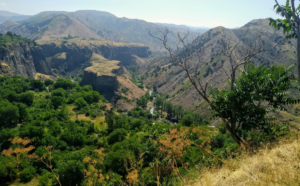Armenian Bread – Lavash

Armenian Bread – Lavash
With this article about LAVASH, we resume our series about Armenia. This series is about the Armenian customs and traditions. It is a very special topic and is very dear to our heart, as it is to the heart of every Armenian. Our customs and traditions are as important for preserving our national character and passing it to the next generation, as is our language, our epic stories, and our culture in general.
We in Armenia cherish and take pride in our customs and traditions. This is why we would like to share them with the world.
The first article in the series of Customs and Traditions is about lavash.
If you have already arrived in Armenia and if the itinerary that has been prepared for you is a good one, then, without doubt, you will find yourself in one of the colorful villages of Armenia. And if you are on your way to a village, you will sense the enjoyable smell of fresh bread while on the road, which means they are baking Lavash somewhere nearby.
What is lavash? Lavash is an Armenian bread, baked in a cylindrical clay oven called “tonir”. They burn dry wood at the bottom of tonir, wait for the fire to come down to ashes, and then, with a swift slap, fix the very thin and smooth dough sheet on the heated walls. Quickly, the sheet starts blushing and swelling, which means lavash bread is ready.
The Ceremony
The entire family participates in a lavash baking ceremony. All family members, save the smallest ones, stay awake until dawn. The eldest (grandma) prepares the dough with grain flour, water and salt then she covers it with a fabric and leaves it until it matures for kneading. While the youngest knead the dough under the leadership of the eldest, the middle generation cooks a meal for the bakers.
Lavash baking starts early in the morning. Once the cattle are off to the pasture, fire is put into the tonir, and tables, cushions, and straw accessories are prepared for kneading the dough. The meal is eagerly boiling in the oven, and an herb tea spreads wonderful fragrance all around, while the melon and watermelon are cooling under the cold running water.
It is time to meet the bakers. It’s a tradition to meet and greet the chief baker with honors since the flavor and aroma of the bread greatly depend on her art of baking. She is met and led to the tonir, and the ceremony commences with the sunrise. The youngest family members fetch the dough, junior bakers divide it into balls, smooth them with dough rods and pass it to the chief baker. She has the most responsible job: she fixes the smoothed thin dough sheets on the oval cushion and rapidly slaps it to the tonir wall. Once lavash starts blushing she takes it from the oven with a metal rod and places it on a straw tray.
Lavash baking ceremony is accompanied with folk songs, special blessings from grandma, and old and kind stories. With the sunset, the bakers finish their work. Their part of baked lavash is their compensation for their work.
By the way, in 2014, lavash baking tradition has been included in the UNESCO intangible cultural heritage list.
By Arpi Harutyunyan-Gasparyan
Tags: Armenian bread, Armenian Cuisine, Bread, Cuisine, Customs and Traditions, Lavash, Rituals




